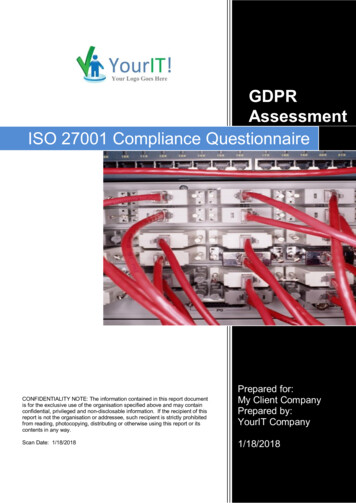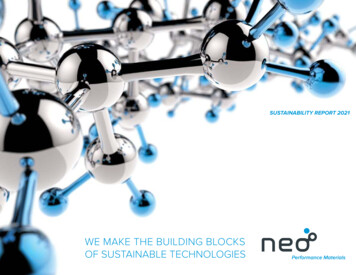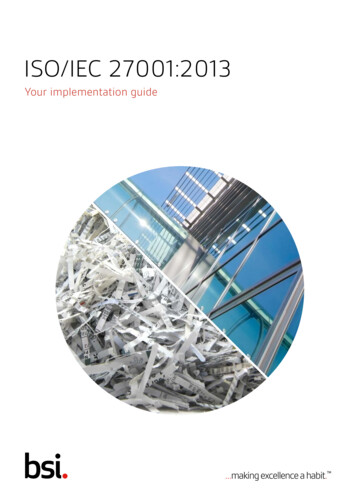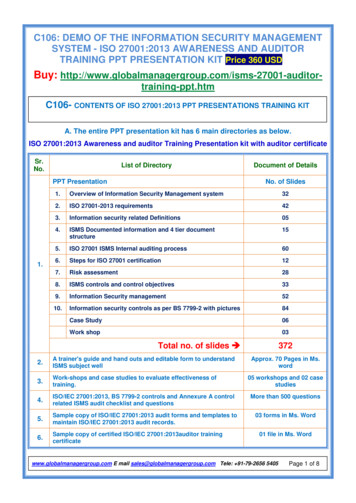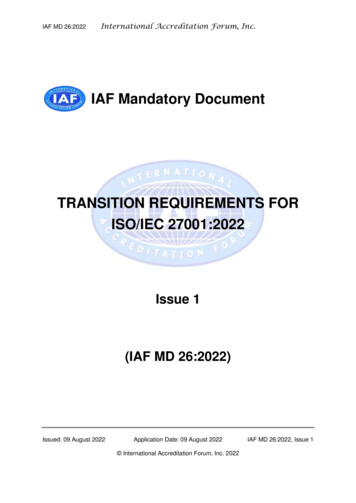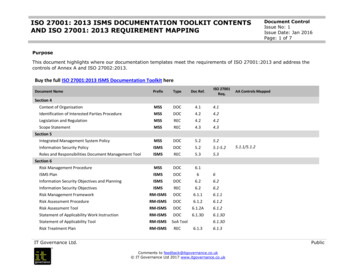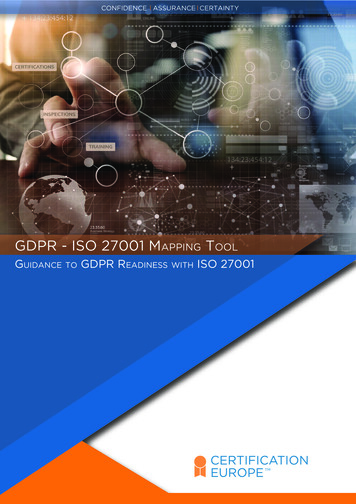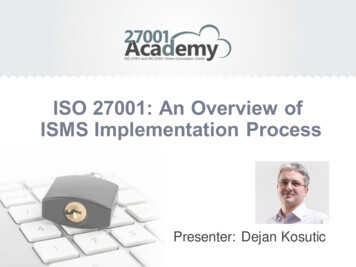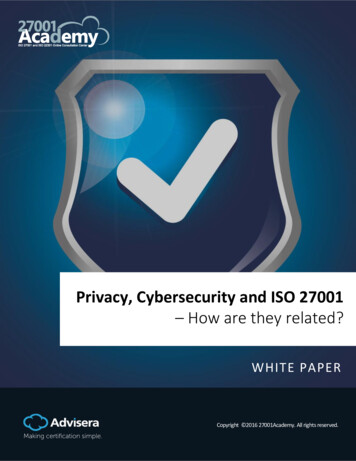
Transcription
Privacy, Cybersecurity and ISO 27001– How are they related?WHITE PAPERCopyright 2016 27001Academy. All rights reserved.Copyright 2016 27001Academy. All rights reserved.1
Table of ContentsIntroduction. 3What should be considered as privacy? . 4Risks to privacy in cyberspace. 5The relations between cyber security and privacy protection . 7Basic principles of implementing cyber security to support privacy protection . 8Practical tools that help cybersecurity implementation for protecting privacy . 9Good privacy practices for users .10Good practices for organizations and governments .11Complementary material . 13References . 13Copyright 2016 27001Academy. All rights reserved.2
IntroductionConcerns about privacy are as old as mankind. From theprotection of one’s body and property in ancient times,it has become a strict connection with when, how, andto what extent data and information about a person arecommunicated to others. And, regardless of body,property, or information, privacy is subject to threecritical factors.First, while people have a desire to protect their privacy,they invariably choose to sacrifice it in exchange forperceived benefits, like money, prestige, orconvenience, disregarding the potential dangers andlosses. Second, the governments’/organizations’ will tolegislate over privacy is not always according toindividuals’ best interests; it is sometimes in the name ofa “greater good.”And, finally, technology. As a key point in dealing withprivacy, technology is increasingly providing the meansfor persons, organizations, and governments to gather,aggregate, and analyze more and more information in afaster way, making privacy breaches, accidental orintentional, increasingly severe and comprehensive.On the other hand, this same technologicalenvironment, known as cyberspace, can providesolutions to help properly protect the privacy ofindividuals, organizations’ business, and governments’affairs, while at the same time allow them to fully enjoymodern life securely. These solutions, together withother non-technological measures, are known as cybersecurity.The purpose of this white paper is to present a view ofhow privacy concepts should be considered incyberspace activities, and how standards andframeworks already available on the market can helpdirect, implement, operate, and improve cyber securityin a comprehensive way.Copyright 2016 27001Academy. All rights reserved.3
What should be considered asprivacy?Although some meanings of privacy may bestraightforward: “the state of being away from otherpeople” or “the state of being away from publicattention,” the boundaries and content of what isconsidered private, and what constitutes an invasion ofprivacy, differ among cultures and individuals (somelanguages do not even have a specific word for“privacy”). However, these common themes often arise:The right to be let alone: when a person choosesseclusion from the attention of others if he/she wishesto do so, including the state of being immune fromscrutiny or being observed in private settings.Limited access: the ability to participate in a group,regardless of its size, without having others collectinformation about them.Control over information: the degree by which a personcan have influence over information abouthimself/herself.States of privacy: privacy is not a binary thing, havingdegrees related to how many people are “secluded”from oneself. Some common levels considered aresolitude (complete separation from others), intimacy(only a pair or small group of individuals share arelationship), anonymity (when someone desires to bein public without being recognized), and reserve (whensomeone requires others to respect his/her need torestrict communication of information concerninghimself or herself).Secrecy: related to any information one wishes toconceal because, in his/her opinion, it has the potentialto be used to his/her disadvantage.It is important to note that although these concepts aremainly directed to people, they are applicable, in somedegree, to organizations and governments as well (e.g.,organizations and governments also have the desire toconceal information they judge can be used to theirdisadvantage).Additionally, it is important to consider that privacy canbe viewed as something absolute, since many timeswrongdoers make use of privacy aspects to conceal theiractivities (that being one of the greatest arguments forthose who want to limit privacy rights).Copyright 2016 27001Academy. All rights reserved.4
Risks to privacy in cyberspaceWhen we consider “cyberspace” as “the electronic world created by interconnected networks of information technologyand the information on those networks,” the Internet being its most remarkable example, and the current and expectedlevels of computational capacity, we can devise the following risk landscape:Threat scenariosVulnerabilitiesRisks Powerful and portablecomputing devices (e.g.,smartphones, tablets, andlaptops) increasingly facilitatinginformation collection,aggregation, and dissemination Increasing number of third-partyrelationships (e.g., connectionand application providers) Increasing concentration ofcyberspace infrastructure (e.g.,datacenters and communicationbackbones) Laws and regulationscompromising privacy Professionalization of attackers(e.g., individual crackers andstate-funded teams) Increasing number of peopleperforming activities in the cyberspace Increasing number of sources tocollect data (e.g., IP cameras,biometric, GPS, RFID, etc.) Uneducated/unaware users regardingcyberspace privacy Lack of privacy protection concerns inapplications / systems development More valuable data beingelectronically stored and processed ona massive and centralized scale (e.g.,data warehouses) Information shared, combined, andlinked together with greater frequency Use of common credentials to accessmultiple systems Collection of information notrequired for primary purpose Maintenance of informationbeyond rightful time of use Disclosure of sensitiveinformation about one’s lifeor business Promotion of incorrectinformation thatcompromises reputation Identity theft Applications / systemswithout proper privacyprotection functionalities /controlsNote: The order in which the threat scenarios, vulnerabilities, and risks are presented does not mean that there is a specificor stronger link between certain items.Copyright 2016 27001Academy. All rights reserved.5
As you can see, while some risks in cyberspace are not much different from those in the physical world, the differencebeing in the speed the impact can spread and its magnitude, others are strictly related to this new technologicalenvironment, like application and systems risks.One tricky thing about privacy risks is that since information value greatly depends on the context in which it is evaluated,some information considered harmless, when combined or aggregated with other information, can result in informationwith great damage potential.Copyright 2016 27001Academy. All rights reserved.6
The relations betweencyber security andprivacy protectionWe can define cyber security as any measures taken to protect and secure online information, and the infrastructure onwhich it resides, from disruption or abuse. The main aspects to be protected are the confidentiality of information storedin Information and Communication Technologies (ICT), the integrity of that information, and the availability and reliabilityof the ICT.Considering the previous definitions for cyber security and privacy concepts, we can see that cyber security is intrinsicallyrelated to privacy protection:Cyber securityPrivacy protectionConfidentiality of information stored in ICTThe most direct aspect of cyber security regarding privacyprotection, encompassing all the discussed concepts (the rightto be let alone, limited access, states of privacy, and secrecy).Integrity of stored / processed informationThis relation is more implicit, since the integrity of the rulesestablished to control who has access to information and whocan alter it must be preserved to ensure user privacy.Availability and reliability of the Information andCommunication Technologies (ICT)ICT assets need to be available and reliable in providing thefunctionalities needed to ensure the proper control of privacy.These relations can be used as more appealing examples of advantages of implementing cyber security, instead of thosemore commonly used as “process organization,” “market advantage,” “cost reduction,” etc., which lack focus on specificresults and make it harder for interested parties to support security initiatives.Copyright 2016 27001Academy. All rights reserved.7
Basic principles ofimplementing cyber securityto support privacy protectionFor a proper implementation of cyber security in a way it can support privacy protection, the following objectives shouldbe considered:Personal autonomy: a person should be capable to make his/her own choices and not be subjected to arbitrary decisions.Self-evaluation and decision making: a person should be given sufficient, relevant, and proper information andknowledge to evaluate when it is appropriate to relinquish his/her privacy rights.Need for limited and protected communication: a person requires opportunities to share confidences with other peopleof his/her choice.In practical terms, these objectives can be fulfilled in a cyber security environment by: Explicit definition of privacy needs and expectations;Development of applications and systems based in solid requirements and frameworks;Education, training, and awareness of people concerning privacy aspects in cyberspace.Copyright 2016 27001Academy. All rights reserved.8
Practical tools that help cybersecurityimplementation for protecting privacyAnd, as in any implementation, selecting the proper framework can save you a lot of trouble and hard work, and for cybersecurity one of the main sources of good practices are the standards of the ISO 27000 family: ISO 27001 (requirements for information security systems management): provides a general framework tohelp protect information, including privacy aspects. See more information in this article: What is ISO 27001?ISO 27032 (guidelines for cyber security): provides guidance for improving the state of cyber security,considering the various security domains, like information security, network security, internet security, andcritical information infrastructure protection (CIIP).As support standards, you should consider: ISO 27002: (code of practice for information security controls) provides detail on how to implement securitycontrols defined in ISO 27001 Annex A. See more information in this article: ISO 27001 vs. ISO 27002 .ISO 27017 (code of practice for information security controls for cloud services): provides details on controlsspecifically related to cloud services. See more information in this article: ISO 27001 vs. ISO 27017 –Information security controls for cloud services.ISO 27018 (code of practice for information security controls related to the protection of Personally IdentifiableInformation – PII): provides details on controls specifically related to protection of Personally IdentifiableInformation – PII. See more information in this article: ISO 27001 vs. ISO 27018 – Standard for protectingprivacy in the cloud.Copyright 2016 27001Academy. All rights reserved.9
Since you can perform the implementation of cyber security as part of an information security project, you can followthe same steps considered for the implementation of an Information Security Management System (ISMS), asdemonstrated in this Diagram of ISO 27001:2013 Implementation, which can be summarized as: Obtaining management (and interested parties) supportDefining requirementsDefining risks to be treatedDefining cyber security architecture (process, technologies, competencies development, etc.)Implementing cyber security controlsOperating and evaluating controls performanceGood privacy practices for usersFrom market good practices, and the previouspresented standards, these can be considered morepractical examples applicable to users:Verify services for privacy policies: if an organizationdoes not have an explicit policy related to how theyprotect your personal information, it is not a good signabout how they handle sensitive information. This samerule is applicable to apps you install on your devices.Think before you post: in social networks, forums, andchats, post only strictly needed information, becausesearch engines can correlate and aggregate randomposts, messages, and profiles and get information youdon’t want them to have.Make use of anonymity: when it is not essential for youto identify your sensitive information, make use ofcredentials with no Personally Identifiable Information,or solutions to navigate anonymously, like TOR.Protect your device and communications: make sure toinstall and maintain firewall, cryptographic (e.g.,veracrypt and VPN), and anti-malware solutions on yourdevice. The first one prevents your device from beinghacked and from remote attacks, the second one helpsprotect your stored data and data in transit, and the lastone can prevent the use of malwares to track yourbrowsing habits. To prevent direct access to them (incase they are stolen), make sure to set passcodes toaccess them every time you use them. And, finally, avoidat any costs making use of open Wi-Fi communication,and if you have to use it, do not send sensitiveinformation. ISO 27002 can help you with more detailedinformation in controls 6.2.1 – Mobile device policy,6.2.2 – Teleworking, and 12.2.1 – Controls againstmalware.Use cryptographic solutions in the cloud: today it isalmost standard for cloud services to encrypt users’ datato prevent unauthorized access. Even so, consideradding your own cryptographic solutions (send yourdata to the cloud already encrypted).Set software for privacy: make sure to configure theprivacy options available in the software you use. “Donot track me” and “delete history after log off” are someoptions you can find.Use your passwords wisely: use different passwordsamong all services you join, especially those you use forencrypted or secure sites. Think about using passwordvault software, which generates and remembers strongand unique passwords, and two-factor authenticationwhenever available. ISO 27002 can help you with moredetailed information in control 9.3.1 – Use of secretauthentication information.Follow your instincts: if you feel uncomfortabledisclosing information, or think the informationrequired is too intrusive, personal, or irrelevant to theservice or content you are trying to obtain, don’t do it.Copyright 2016 27001Academy. All rights reserved.10
Good practices for organizations and governmentsAs the parties responsible for the cyberspace maininfrastructure, and massive user databases,organizations and governments should be highlyconcerned about the protection of this sensitiveinformation. In the text below you will see somepractical examples applicable to organizations andgovernments that are supported by the previouspresented standards. For more information about ISO27001 and best practices for compliance, please see thisISO 27001:2013 Foundations Course.Have (and follow) a privacy policy: an organizationshould have clear guidelines for its users and employeesabout what information is collected, for what purpose,how it is used, for how long it is kept, and how it isprotected. Note that these guidelines shall be compliantwith local laws and regulations, so you will need to mapthese legal requirements, too. ISO 27002 can help youwith more detailed information in control 5.5.1 –Policies for information security, and 18.1.1 –Identification of applicable legislation and contractualrequirements. For more information about policiesdevelopment, please see this article: Seven steps forimplementing policies and procedures.Know what you have: a data inventory should beavailable to tell an organization all the personalinformation it has about users, who is responsible for it,and who can have access to it. ISO 27002 can help youwith more detailed information in controls 8.1.1 –Inventory of assets, 8.1.2 – Ownership of assets, and9.1.1 – Access control policy. For more informationabout the asset inventory, please see this article: How tohandle Asset register (Asset inventory) according to ISO27001.Include privacy requirements in the application /systems development process: simple requirementssuch as privacy embedded into the design, leastprivilege user access, privacy as a default setting, andend-to-end security (e.g., from user to database) may besufficient for software architects, developers, andprogrammers to understand that privacy concerns mustbe an essential part of application / systemdevelopment and maintenance. ISO 27002 can help youwith more detailed information in controls 14.1.1 –Information security requirements analysis andspecification, 18.1.3 – Protection of records, and 18.1.4– Privacy and protection of personally identifiableinformation. For more information about informationsystems requirements, please see this article: How toset security requirements and test systems according toISO 27001.Enforce policies: it is not because there is a policy inplace that everyone will follow it. So, you should,whenever possible, ensure that following the policy isthe only way to use the system. For example, if thesystem defines that the minimum password length is sixcharacters, as established in the policy, there is no waya user can set a shorter password. ISO 27002 can helpyou with more detailed information in controls 6.2.1 –Mobile device policy, 6.2.1 – teleworking, 9.1.1 – Accesscontrol policy, 9.4.1 – Information access restriction, and9.4.2 – Secure log-on procedures. For more informationabout policies enforcement, please see this article:Seven steps for implementing policies and procedures.Provide means to educate users: privacy pages,newsletters, video training, and others forms ofeducation should be considered to make users (e.g.,clients, employees, third parties, etc.) aware of whatthey should do to protect their privacy and the privacyof others. ISO 27002 can help you with more detailedinformation in control 7.2.2 – Information securityawareness, education and training. For moreinformation about user training, please see thesearticles: 8 Security Practices to Use in Your EmployeeTraining and Awareness Program and How to performtraining & awareness for ISO 27001 and ISO 22301.Copyright 2016 27001Academy. All rights reserved.11
Keep your infrastructure lean and updated: having onlythe minimal resources necessary to run the business,and updated concerning security patches, will minimizethe attack surface someone can use to compromiseyour users’ privacy. ISO 27002 can help you with moredetailed information in control 12.5.1 – Installation ofsoftware on operational systems, 12.6.1 – Managementof technical vulnerabilities, and 12.6.2 – Restrictions onsoftware installation. For more orientation aboutoperational software control, please see this article:Implementing restrictions on software installation usingISO 27001 control A.12.6.2.Control changes: access of new or updated assets cancompromise all your security efforts. Make sure thatchanges in your technological environment will notaffect your security levels. ISO 27002 can help you withmore detailed information in control 12.1.2 – Changemanagement. For more information about changecontrol, please see this article: How to manage changesin an ISMS according to ISO 27001 A.12.1.2.Secure your network and communications: make surethat data from your users are kept safe while in transit(e.g., by the use of VPN, SSL, HTTPS, etc.). Even theorganization’s internal networks and communicationsshould consider protective measures. ISO 27002 canhelp you with more detailed information in control13.1.2 – Security of network services.Be prepared for data breaches: these kinds of incidentsare inevitable (your efforts will only make them lesslikely to happen), and you should be prepared torespond to them in the quickest and most proper way.A good response will not only minimize damage tousers’ trust, but may minimize legal problems byshowing the organization’s due care with users’sensitive data. ISO 27002 can help you with moredetailed information in controls 16.1.1 – Responsibilitiesand procedures, and 16.1.5 – Response to informationsecurity incidents. For more information about incidenthandling, please see this article: How to handle incidentsaccording to ISO 27001 A.16.Periodic evaluation: by means of audits, vulnerabilityscans, and penetration tests, an organization can assessand evaluate the effectiveness of its security controlsand make proper adjustments to maintain securitylevels. Simulation of data breaches also should beconsidered to evaluate the performance of responseplans. ISO 27002 can help you with more detailedinformation in control 18.2.1 – Independent review ofinformation security, 18.2.2 – Compliance with securitypolicies and standards, and 18.2.3 – Technicalcompliance review. For more information aboutevaluation forms, please see this article: How to usepenetration testing for ISO 27001 A.12.6.1.Provide a communication channel: users do not wantonly to be told about what an organization proposes toprotect their data. They want to ask questions and beheard about complaints. By making a page, phonenumber, e-mail, or some other forms of communicationavailable, and responding to users’ inputs, anorganization can improve its image as a trustworthydata/information keeper. ISO 27001 can help you withmore detailed information in clause 7.4 –Communication. For more orientation aboutcommunication procedures, please see this article: Howto create a Communication Plan according to ISO 27001.Please note that some of these previous examples alsocan be applicable to individual users, but are morerecommended to organizations and governmentsbecause of the costs they can save due to the sheer datavolume they handle.Copyright 2016 27001Academy. All rights reserved.12
Complementary materialAs for documentation support, here are some documentation templates, available at Advisera:PracticeDocument nameHave (and follow) a privacy policyList of Legal, Regulatory, Contractual and Other RequirementsProtect your device and communicationsMobile Device and Teleworking PolicyBring Your Own Device (BYOD) PolicyKnow what you haveInventory of AssetsEnforce policiesAccess Control PolicyEnforce policiesPassword PolicyControl changesChange Management PolicyInclude privacy requirements in theapplication / systems development processSpecification of Information System RequirementsBe prepared for data breachesIncident Management ProcedurePeriodic evaluationInternal Audit ChecklistSo, with some adjustments to your business context, these documents can be used as the basis for your organization’scyberspace and cyber security environment.ReferencesADVISERA – 27001Academy (http://advisera.com/27001academy/)Kosutic, D., 2012. 9 Steps to Cybersecurity - The Manager’s Information Security Strategy Manual.Westin, A. F., 1967. Privacy & Freedom.OXFORD DICTIONARIES ish/privacy)MERRIAM WEBSTER )Copyright 2016 27001Academy. All rights reserved.13
EPPS Services Ltd.for electronic business and business consultingZavizanska 12, 10000 ZagrebCroatia, European UnionEmail: support@advisera.comPhone: 1 (646) 759 9933Toll-Free (U.S. and Canada): 1-888-553-2256Toll-Free (United Kingdom): 0800 808 5485Fax: 385 1 556 0711Copyright 2016 27001Academy. All rights reserved.14
ISO 27002: (code of practice for information security controls) provides detail on how to implement security controls defined in ISO 27001 Annex A. See more information in this article: ISO 27001 vs. ISO 27002 . ISO 27017 (code of practice for information security controls for cloud services): provides details on controls

